Development, Testing, and Thermoforming of Thermoplastics Reinforced with Surface-Modified Aramid Fibers for Cover of Electronic Parts in Small Unmanned Aerial Vehicles Using 3D-Printed Molds
Abstract
:1. Introduction
2. Materials and Methods
2.1. Raw Materials
2.2. Modification of Aramid Fiber Surface by Sol–Gel Technique
2.3. Composite Processing
2.4. Production of Plates for Physical–Mechanical Tests and Films for Thermoforming
2.5. Mold Design Development
2.6. Molds’ Development
2.7. Thermoforming of the Composite Sheets
2.8. Measurements
3. Results and Discussion
3.1. FTIR Analysis of the Surface of Raw and SiO2-Modified Aramid Fibers
3.2. SEM and EDS Analysis of Raw and SiO2-Modified Aramid Fibers
3.3. Assessment of Physical–Mechanical Properties of Composite Materials Reinforced with Aramid Fibers
3.3.1. Tensile Behavior
3.3.2. Flexural Behavior
3.3.3. Impact Strength
3.3.4. Analysis of Water Contact Angle and Surface Energy Obtained on Composites Reinforced with Aramid Fibers
3.4. FTIR Analysis on Polymer Composites Reinforced with Aramid Fibers
3.5. DSC-TG Analysis
3.6. Optical Microscopy
3.7. SEM Analysis
3.8. FTIR Microscopy
3.9. Production of Cover for the Drone and Flight Test
4. Conclusions
Author Contributions
Funding
Institutional Review Board Statement
Data Availability Statement
Acknowledgments
Conflicts of Interest
References
- Brooks, R.A.; Wang, H.; Ding, Z.; Xu, J.; Song, Q.; Liu, H.; Dear, J.P.; Li, N. A review on stamp forming of continuous fibre-reinforced thermoplastics. Int. J. Lightweight Mater. Manuf. 2022, 5, 411–430. [Google Scholar] [CrossRef]
- Agwa, M.Y.S.; Ali-Eldin, S.S.; Megahed, M. Integrated vacuum assisted resin infusion and resin transfer molding technique for manufacturing of nano-filled glass fiber reinforced epoxy composite. J. Ind. Text. 2022, 51, 5113S–5144S. [Google Scholar] [CrossRef]
- Bhandari, S. Feasibility of Using 3D Printed Molds for Thermoforming Thermoplastic Composites. Master’s Thesis, University of Maine, Orono, ME, USA, 2017. [Google Scholar]
- Stratasys White Paper—Additively Manufactured Composite Tooling. 2020. Available online: https://www.stratasys.com/en/resources/whitepapers/additively-manufactured-composite-tooling/ (accessed on 15 June 2024).
- Formlabs. Carbon Fiber Parts Manufacturing with 3D Printed Molds; White Paper; Formlabs: Somerville, MA, USA, 2021. [Google Scholar]
- Stratasys, Precision Prototyping: The Role of 3D Printed Molds in the Injection Molding Industry. White Paper-Stratasys. 2014. Available online: https://www.stratasys.com/en/resources/whitepapers/precision-prototyping (accessed on 20 June 2024).
- Sztorch, B.; Brząkalski, B.; Jałbrzykowski, M.; Przekop, R.E. Processing Technologies for Crisis Response on the Example of COVID-19 Pandemic-Injection Molding and FFF Case Study. Processes 2021, 9, 791. [Google Scholar] [CrossRef]
- The CASTOR Team. Additive Manufacturing Tooling—Why 3D Printing Technology Is Ideal for Jigs, Tools & Fixtures. 2023. Available online: https://www.3dcastor.com/post/why-3d-printing-is-the-best-solution-for-tooling (accessed on 18 June 2023).
- Hong, F.; Tendera, L.; Myant, C.; Boyle, D. Vacuum-Formed 3D Printed Electronics: Fabrication of Thin, Rigid and Free-Form Interactive Surfaces. SN Comput. Sci. 2022, 3, 275. [Google Scholar] [CrossRef]
- Bloom, M. Thermoforming process tutorial. Sinotech. 2014. Available online: https://sinotech.com/wp-content/uploads/Sinotech_Digital-Asset_Thermoforming.pdf (accessed on 10 June 2024).
- Hwang, S.-F.; Tsai, Y.-C.; Tsai, C.-L.; Wang, C.-H.; Liu, H.-K. Thermoforming simulation of woven carbon fiber fabric/polyurethane composite materials. Appl. Sci. 2024, 14, 445. [Google Scholar] [CrossRef]
- Wittmann, L.-M.; Drummer, D. Multilayer sheets for thermoforming non thermoformable polymers. J. Plast. Film. Sheeting 2022, 38, 225–244. [Google Scholar] [CrossRef]
- Zampaloni, M.A.; Pourboghrat, F.; Yu, W.R. Stamp Thermo-Hydroforming: A New Method for Processing Fiber-Reinforced Thermoplastic Composite Sheets. J. Thermoplast. Compos. Mater. 2004, 17, 31–50. [Google Scholar] [CrossRef]
- Striewe, J.; Reuter, C.; Sauerland, K.-H.; Tröster, T. Manufacturing and crashworthiness of fabric-reinforced thermoplastic composites. Thin-Walled Struct. 2018, 123, 501–508. [Google Scholar] [CrossRef]
- Behrens, B.-A.; Raatz, A.; Hübner, S.; Bonk, C.; Bohne, F.; Bruns, C.; Micke-Camuz, M. Automated stamp forming of continuous fiber reinforced thermoplastics for complex shell geometries. Procedia CIRP 2017, 66, 113–118. [Google Scholar] [CrossRef]
- Maron, B.G.; Garthaus, C.; Hornig, A.; Lenz, F.; Hubner, M. Forming of carbon fiber reinforced thermoplastic composite tubes-Experimental and numerical approaches. CIRP J. Manuf. Sci. Technol. 2017, 17, 60–64. [Google Scholar] [CrossRef]
- Formlabs. White Paper. Low-Volume Rapid Thermoforming with 3D Printed Molds. 2022. Available online: https://3d.formlabs.com/thermoforming/#form (accessed on 21 June 2024).
- Junk, S.; Sämann-Sun, J.; Niederhofer, M. Application of 3D Printing for the Rapid Tooling of Thermoforming Moulds. In Proceedings of the 36th International MATADOR Conference; Springer: London, UK, 2010. [Google Scholar]
- Serrano-Mira, J.; Gual-Ortí, J.; Bruscas-Bellido, G.; Abellán-Nebot, J. Use of additive manufacturing to obtain moulds to thermoform tactile graphics for people with visual impairment. Procedia Manuf. 2017, 13, 810–817. [Google Scholar] [CrossRef]
- Zhang, W.; Zelinsky, G.; Samaras, D. Real-time accurate object detection using multiple resolutions. In Proceedings of the 2007 IEEE 11th International Conference on Computer Vision, Rio de Janeiro, Brazil, 14–21 October 2007; pp. 1–8. [Google Scholar]
- Vijayavargiya, A.; Anirudh, A.S.; Kumar, A.; Kumar, A.; Yadav, A.; Sharma, A.; Jangid, A.; Dubey, A. Unmanned Aerial Vehicle. Imp. J. Interdiscip. Res. 2016, 2. Available online: https://www.semanticscholar.org/paper/Unmanned-Aerial-Vehicle-Vijayavargiya-Sharma/3235f1cc71a4102ca88925dd53137fbde0dac80d#extracted (accessed on 5 June 2024).
- Yasin, J.N.; Mohamed, S.A.S.; Haghbayan, M.-H.; Heikkonen, J.; Tenhunen, H.; Plosila, J. Unmanned aerial vehicles (UAVs): Collision avoidance systems and approaches. IEEE Access 2020, 8, 105139. [Google Scholar] [CrossRef]
- Das, N.; Das, S.; Mishra, D.K.; Pandey, K.M. Analysis of deformation and mode shape in the landing gear of light Unmanned Aerial Vehicle. J. Phys. Conf. Ser. 2020, 1455, 1–6. [Google Scholar] [CrossRef]
- Zeyrek, B.Y.; Aydogan, B.; Dilekcan, E.; Ozturk, F. Review of thermoplastic composites in aerospace industry. Int. J. Eng. Technol. Informatic. 2022, 3, 1–6. [Google Scholar]
- Oribi, High-Volume Composite Blades and Composite Propellers Manufacturer for Drones and UAVs. Available online: https://oribicomposites.com/thermoplastic-uav-drone-blade-propeller-manufacturer (accessed on 21 June 2024).
- Celanse, Drones. Available online: https://www.celanese.com/applications/drones (accessed on 21 June 2024).
- Synesqo, Small Delivery Drones Products. Available online: https://www.syensqo.com/en/solutions-market/aerospace/advanced-air-mobility/small-delivery-drones/products (accessed on 22 June 2024).
- Sabic, Pushing the Boundaries of Drone Designs with Advanced Thermoplastics. 2021. Available online: https://www.sabic.com/en/industries/electrical-and-electronics/electronic-devices-displays/drones (accessed on 22 June 2024).
- Junk, S.; Schrock, S.; Schröder, W. Additive tooling for ther-moforming a cowling of an UAV using binder jetting. AIP Conf. Proc. 2019, 2113, 150001. [Google Scholar]
- Erchiqui, F.; Souli, M. Numerical investigation on the use of wood-plastic composites for the thermoforming of NACA profile for UAVs. In Multiphysics: Advances and Applications, Multiphysics Simulations in Automotive and Aerospace Applications; Moatamedi, M., Rahulan, T., Khawaja, H., Eds.; Academic Press: Cambridge, MA, USA, 2021; pp. 209–238. [Google Scholar]
- Erchiqui, F.; Talla, A.F.; Kaddami, H. A numerical investigation of the use of novel melt processed PET-hemp fiber composites for thermoforming applications. Polym. Eng. Sci. 2016, 56, 1021–1030. [Google Scholar] [CrossRef]
- Fouad, E.; Baatti, A.; Ben Hamou, K.; Kaddami, H.; Souli, M.; Imad, A. Investigation on the thermoforming of PMSQ-HDPE for the manufacture of a NACA profile of small dimensions. Polymers 2021, 13, 1622. [Google Scholar] [CrossRef]
- Zhang, L.; Kong, H.; Qiao, M.; Ding, X.; Yu, M. Growing nano-SiO2 on the surface of aramid fibers assisted by supercritical CO2 to enhance the thermal stability, interfacial shear strength, and UV resistance. Polymers 2019, 11, 1397. [Google Scholar] [CrossRef]
- SR EN ISO 527-1:2020; Plastics—Determination of tensile properties—Part 1: General principles, International Organization for Standardization, Geneve, Switzerland purchased through ASRO. Romanian Standards Association: Bucharest, Romania, 2020.
- SR EN ISO 179-1:2023; Plastics—Determination of Charpy impact properties—Part 1: Non-instrumented impact test. International Organization for Standardization, Geneve, Switzerland purchased through ASRO. Romanian Standards Association: Bucharest, Romania, 2023.
- SR EN ISO 178:2019; Plastics—Determination of Flexural Properties. International Organization for Standardization, Geneve, Switzerland purchased through ASRO. Romanian Standards Association: Bucharest, Romania, 2019.
- Trademark, R. Stratasys Inc FDM-Trademark Details-Serial Number 74133656, Registration Number 1663961. 1991. Available online: https://trademarks.justia.com/741/33/fdm-74133656.html (accessed on 17 June 2024).
- Markforged, Onyx Material Datasheet. Available online: https://markforged.com/materials/plastics/onyx (accessed on 15 April 2024).
- European Union Aviation Safety Agency, Operations Manual Example for UAS operations at SAIL II. 2022. Available online: https://www.easa.europa.eu/en/document-library/general-publications/drones/easa-operations-manual-example-uas-operations-sail-ii (accessed on 15 May 2024).
- MIL-STD-810G; Department of Defense Test Method Standard—Environmental Engineering Considerations and Laboratory Tests. Department of Defence USA: Arlington, VA, USA, 31 October 2008.
- Clarke, A.R. Microscopy Techniques for Materials Science; Clarke, A., Eberhardt, C., Eds.; Woodhead Publishing Limited: Sawston, UK, 2002. [Google Scholar]
- Makarenko, K.I.; Nikitin, A.; Parenko, A. Fractographic Analysis of Fractures of Graphitized Cast Iron Using Optical Microscopy. 2020. Available online: https://api.semanticscholar.org/CorpusID:230631801 (accessed on 9 June 2024).
- Khandare, P. Qualitative analysis of aramide polymers by FT-IR spectroscopy. Int. J. Eng. Sci. Invent. 2014, 3, 1–7. [Google Scholar]
- Li, Y.; Luo, Z.; Yang, L.; Li, X.; Xiang, K. Study on surface properties of aramid fiber modified in supercritical carbon dioxide by glycidyl-POSS. Polymers 2019, 11, 700. [Google Scholar] [CrossRef]
- Xu, K.; Ou, Y.; Li, Y.; Su, L.; Lin, M.; Li, Y.; Cui, J.; Liu, D. Preparation of robust aramid composite papers exhibiting water resistance by partial dissolution/regeneration welding. Mater. Des. 2020, 187, 108404. [Google Scholar] [CrossRef]
- Almaroof, A.; Ali, A.; Mannocci, F.; Deb, S. Semi-interpenetrating network composites reinforced with Kevlar fibers for dental post fabrication. Dent. Mater. J. 2018, 38, 511–521. [Google Scholar] [CrossRef] [PubMed]
- Demir, A.; Bozacı, E.; Gülümser, T.; Sarıkanat, M. An ecological approach for the surface modification of aramid fibers. Text. Appar. 2016, 26, 256–261. [Google Scholar]
- Gui-Long, X.; Deng, C.; Yun, L.; Pi-Hui, P.; Jian, H.; Zhuoru, Y. Preparation and characterization of raspberry-like SiO2 particles by the sol-gel method. Nanomater. Nanotechnol. 2011, 1, 79–83. [Google Scholar] [CrossRef]
- Liang, Y.; Ouyang, J.; Wang, H.; Wang, W.; Chui, P.; Sun, K. Synthesis and characterization of core-shell structured SiO2@YVO4:Yb3+, Er3+ microspheres. Appl. Surf. Sci. 2012, 258, 3689–3694. [Google Scholar] [CrossRef]
- Talreja, K.; Chauhan, I.; Ghosh, A.; Majumdar, A.; Butola, B.S. Functionalization of silica particles to tune the impact resistance of shear thickening fluid treated aramid fabrics. RSC Adv. 2017, 78, 49787–49794. [Google Scholar] [CrossRef]
- Ding, H.; Kong, H.; Sun, H.; Xu, Q.; Zeng, J.; Yu, M. Improving aramid pulp dispersion in epoxy resin via the in situ preparation of SiO2 on an aramid pulp surface. Polym. Compos. 2019, 41, 1683–1693. [Google Scholar] [CrossRef]
- Zhou, J.; Liu, X.; He, X.; Wang, H.; Ma, D.; Lu, X. Bio-inspired aramid fibers@silica binary synergistic aerogels with high thermal insulation and fire retardant performance. Polymers 2023, 15, 141. [Google Scholar] [CrossRef] [PubMed]
- Lu, Z.; Hu, W.; Xie, F.; Zhuo, L.; Yang, B. Sol–gel synthesis of nanosilica-coated para-aramid fibers and their application in the preparation of paper-based friction materials. RSC Adv. 2017, 7, 30632–30639. [Google Scholar] [CrossRef]
- He, S.; Sun, G.; Cheng, X.; Dai, H.; Chen, X. Nanoporous SiO2 grafted aramid fibers with low thermal conductivity. Compos. Sci. Technol. 2017, 146, 91–98. [Google Scholar] [CrossRef]
- Pelin, C.; Sonmez, M.; Pelin, G.; Stefan, A.; Stelescu, M.D.; Ignat, M.; Gurau, D.; Georgescu, M.; Nituica, M. Composites based on polymeric blends reinforced with TiO2 modified aramid fibers. Polym. Compos. 2024, 45, 116–7136. [Google Scholar] [CrossRef]
- Tai, C.M.; Li, R.K.; Ng, C.N. Impact behaviour of polypropylene/polyethylene blends. Polym. Test. 2000, 19, 143–154. [Google Scholar] [CrossRef]
- Titone, V.; Mistretta, M.C.; Botta, L.; Mantia FP, L. Investigation on the properties and on the photo-oxidation behaviour of polypropylene/fumed silica nanocomposites. Polymers 2021, 13, 2673. [Google Scholar] [CrossRef]
- Belgacem, C.; Serra-Parareda, F.; Tarrés, Q.; Mutjé, P.; Delgado-Aguilar, M.; Boufi, S. The integral utilization of date palm waste to produce plastic composites. Polymers 2021, 13, 2335. [Google Scholar] [CrossRef] [PubMed]
- Ari, A.; Bayram, A.; Karahan, M.; Karagöz, S. Comparison of the mechanical properties of chopped glass, carbon, and aramid fiber reinforced polypropylene. Polym. Polym. Compos. 2022, 30, 09673911221098570. [Google Scholar] [CrossRef]
- Arı, A.; Bayram, A.; Karahan, M.; Arslan, O. Comparative evaluation of mechanical properties of short aramid fiber on thermoplastic polymers. Mater. Sci. Pol. 2023, 41, 161–176. [Google Scholar] [CrossRef]
- Li, Y.; Xiong, Y.; Zhang, Q. Rivet-inspired modification of aramid fiber by decorating with silica particles to enhance the interfacial interaction and mechanical properties of rubber composites. Materials 2020, 13, 2665. [Google Scholar] [CrossRef]
- Cheon, J.; Cho, D. Effect of MWCNT anchoring to para-aramid fiber surface on the thermal, mechanical, and impact properties of para-aramid fabric-reinforced vinyl ester composites. J. Compos. Sci. 2023, 7, 416. [Google Scholar] [CrossRef]
- Tang, C.; Li, X.; Li, Z.; Hao, J. Interfacial hydrogen bonds and their influence mechanism on increasing the thermal stability of nano-SiO2-modified meta-aramid fibres. Polymers 2017, 9, 504. [Google Scholar] [CrossRef]
- Die, J.; Ma, J.; Li, H.; Zhang, Y.; Li, F.; Cao, Y.; Hao, W.; Tu, J.; Zhang, K.; Yu, R. Effects of maleic anhydride-grafted polyethylene on the properties of artificial marble waste powder/linear low-density polyethylene composites with ultra-high filling content. Materials 2023, 16, 4036. [Google Scholar] [CrossRef] [PubMed]
- Eftekhari, M.; Fatemi, A. Tensile behavior of thermoplastic composites including temperature, moisture, and hygrothermal effects. Polym. Test. 2016, 51, 151–164. [Google Scholar] [CrossRef]
- Hossain, M.S.; Hossain, M.S.; Rahman, M.M.; Chowdhury, A.S.; Khan, R. A Fabrication and characterization of Kevlar fiber reinforced polypropylene based composite for civil applications. Adv. Mater. 2018, 7, 105–110. [Google Scholar]
- Wang, W.; Guo, X.; Liu, L.; Zhang, R.; Yu, J. Effect of temperature and strain rate on the flexural behavior of wood-polypropylene composites. Materials 2019, 12, 3987. [Google Scholar] [CrossRef] [PubMed]
- Takayama, T.; Kobayashi, S.; Yuasa, Y.; Jiang, Q. Effect of carbon nanofiber distribution on mechanical properties of injection-molded aramid-fiber-reinforced polypropylene. Polymers 2024, 16, 1110. [Google Scholar] [CrossRef] [PubMed]
- Bikiaris, D.N.; Vassiliou, A.; Pavlidou, E.; Karayannidis, G.P. Compatibilisation effect of PP-g-MA copolymer on iPP/SiO2 nanocomposites prepared by melt mixing. Eur. Polym. J. 2005, 41, 1965–1978. [Google Scholar] [CrossRef]
- Bula, K.; Jesionowski, T. Effect of polyethylene functionalization on mechanical properties and morphology of PE/SiO2 composites. Instrum. Sci. Technol. 2010, 17, 603–614. [Google Scholar] [CrossRef]
- Palola, S.; Javanshour, F.; Kolahgar Azari, S.; Koutsos, V.; Sarlin, E. One Surface Treatment, Multiple Possibilities: Broadening the Use-Potential of Para-Aramid Fibers with Mechanical Adhesion. Polymers 2021, 13, 3114. [Google Scholar] [CrossRef]
- Palola, S.; Vuorinen, J.; Noordermeer, J.W.; Sarlin, E. Development in additive methods in aramid fiber surface modification to increase fiber-matrix adhesion: A Review. Coatings 2020, 10, 556. [Google Scholar] [CrossRef]
- Jaiswal, G.; Singha, M.K.; Das, D. Mechanical behavior of aramid-polypropylene fiberweb composites. Compos. Struct. 2021, 268, 113938. [Google Scholar] [CrossRef]
- Fu, S.; Yu, B.; Tang, W.; Fan, M.; Chen, F.; Fu, Q. Mechanical properties of polypropylene composites reinforced by hydrolyzed and microfibrillated Kevlar fibers. Compos. Sci. Technol. Adv. Mater. 2018, 163, 141–150. [Google Scholar] [CrossRef]
- Hao, W.; Yao, X.; Ke, Y.; Ma, Y.; Li, F. Experimental characterization of contact angle and surface energy on aramid fibers. J. Adhes. Sci. Technol. 2013, 27, 1012–1022. [Google Scholar] [CrossRef]
- Biswas, M.K.; Shayed, M.A.; Hund, R.D.; Cherif, C. Surface modification of Twaron aramid fiber by the atmospheric air plasma technique. Text. Res. J. 2012, 83, 406–417. [Google Scholar] [CrossRef]
- Wang, C.; Yang, H.; Chen, F.; Peng, L.; Gao, H.F.; Zhao, L.P. Influences of VTMS/SiO2 ratios on the contact angle and morphology of modified super-hydrophobic silicon dioxide material by vinyl trimethoxy silane. Results Phys. 2018, 10, 891–902. [Google Scholar] [CrossRef]
- Schreier, P.; Trassl, C.; Altstädt, V. Surface modification of polypropylene based particle foams. AIP Conf. Proc. 2014, 1593, 378–382. [Google Scholar]
- Smith, B.C. The Infrared spectra of polymers III: Hydrocarbon polymers. Spectroscopy 2021, 36, 22–25. [Google Scholar] [CrossRef]
- da Silveira, P.H.P.M.; Santos, M.C.C.d.; Chaves, Y.S.; Ribeiro, M.P.; Marchi, B.Z.; Monteiro, S.N.; Gomes, A.V.; Tapanes, N.d.L.C.O.; Pereira, P.S.d.C.; Bastos, D.C. Characterization of thermo-mechanical and chemical properties of polypropylene/hemp fiber biocomposites: Impact of maleic anhydride compatibilizer and fiber content. Polymers 2023, 15, 3271. [Google Scholar] [CrossRef]
- Fang, J.; Zhang, L.; Sutton, D.; Wang, X.; Lin, T. Needleless melt-electrospinning of polypropylene nanofibres. J. Nanomater. 2012, 2012, 382639. [Google Scholar] [CrossRef]
- El-Wakil, A.A.; Moustafa, H.; Abdel-Hakim, A. Efect of LDPE-g-MA as a compatibilizer for LDPE/PA6 blend on the phase morphology and mechanical properties. Polym. Bull. 2021, 79, 2249–2262. [Google Scholar] [CrossRef]
- Saini, A.; Yadav, C.; Bera, M.; Gupta, P.; Maji, P.K. Maleic anhydride grafted linear low density polyethylene/waste paper powder composites with superior mechanical behavior. J. Appl. Polym. Sci. 2017, 134, 45167. [Google Scholar] [CrossRef]
- Smith, B. The Infrared Spectra of Polymers II: Polyethylene. Spectroscopy 2021, 36, 24–29. [Google Scholar] [CrossRef]
- Lisperguer, J.; Nuñez, C.; Perez-Guerrero, P. Structure and thermal properties of maleated lignin-recycled polystyrene composites. J. Chil. Chem. Soc. 2013, 58, 1937–1940. [Google Scholar] [CrossRef]
- Wen, X. One-pot route to graft long-chain polymer onto silica nanoparticles and its application for highperformance poly(L-lactide) nanocomposites. RSC Adv. 2019, 9, 13908–13915. [Google Scholar] [CrossRef]
- Aytan, E.; Aytekin, Y.S.; Aytan, T.A.; Esenturk, O.; Kahraman, M.V. Facile application of terahertz spectroscopy in UV-coated and phase change material loaded MPS. Polym. Bull. 2023, 81, 2447–2464. [Google Scholar] [CrossRef]
- Bosenbecker, M.W.; Silva, E.V.; Paganotto, G.F.d.R.; Zanon, T.T.M.; Langone, F.; Rodrigues, M.B.B.; Marini, J.; Labidi, J.; Missio, A.L.; de Oliveira, A.D. Effect of Different Compatibilizers on the Properties of Green Low-Density Polyethylene Composites Reinforced with Bambusa Vulgaris Bamboo Fibers. Polymers 2024, 16, 1760. [Google Scholar] [CrossRef]
- Kalajahi, P.F.; Shahbazi, A.; Shelesh-Nezhad, K.; Arsalani, N. The effects of aramid short fiber and CaCO3 nanoparticles inclusions on the elastic, damping, and thermal behavior of polypropylene composite. J. Thermoplast. Compos. Mater. 2020, 33, 1707–1720. [Google Scholar] [CrossRef]
- Motelica, L.; Ficai, D.; Oprea, O.-C.; Trusca, R.-D.; Ficai, A.; Stelescu, M.D.; Sonmez, M.; Nituica, M.; Mustatea, G.; Holban, A.M. Antimicrobial packaging for plum tomatoes based on ZnO modified low-density polyethylene. Int. J. Mol. Sci. 2024, 25, 6073. [Google Scholar] [CrossRef]

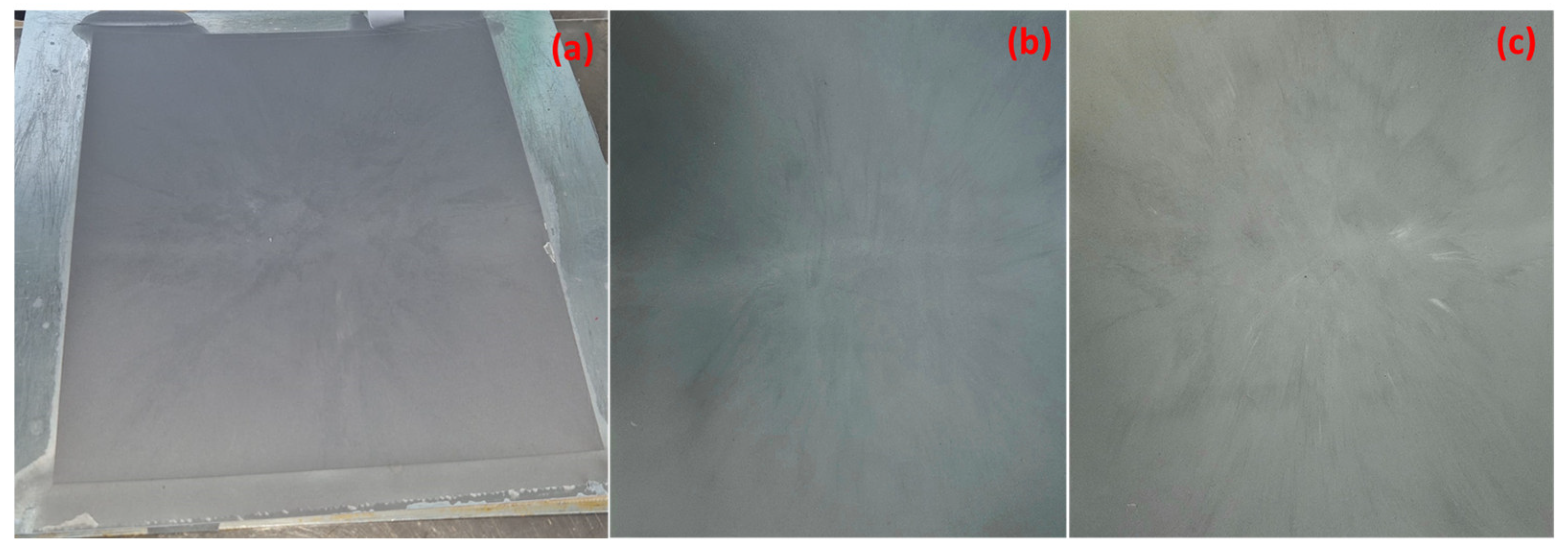
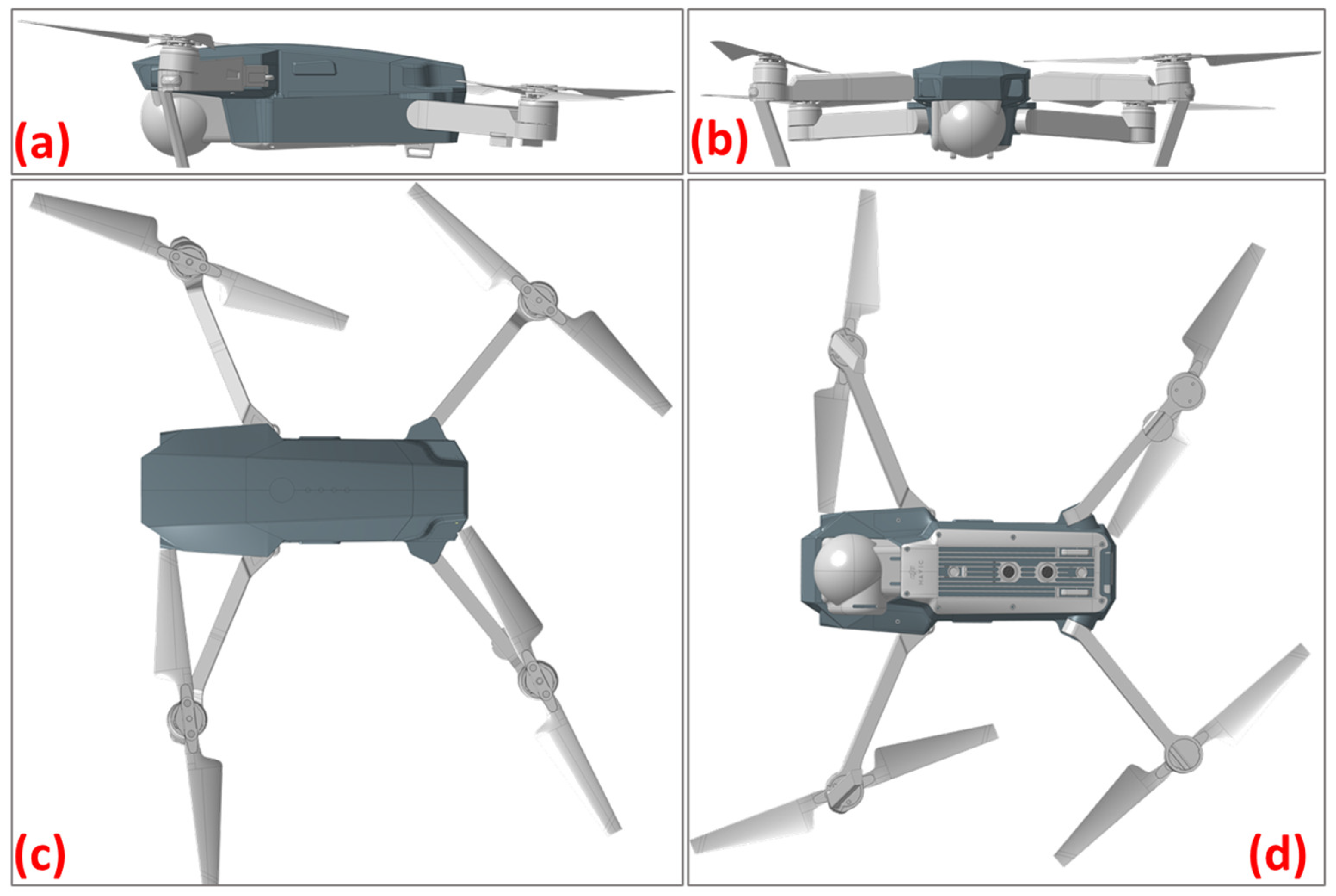



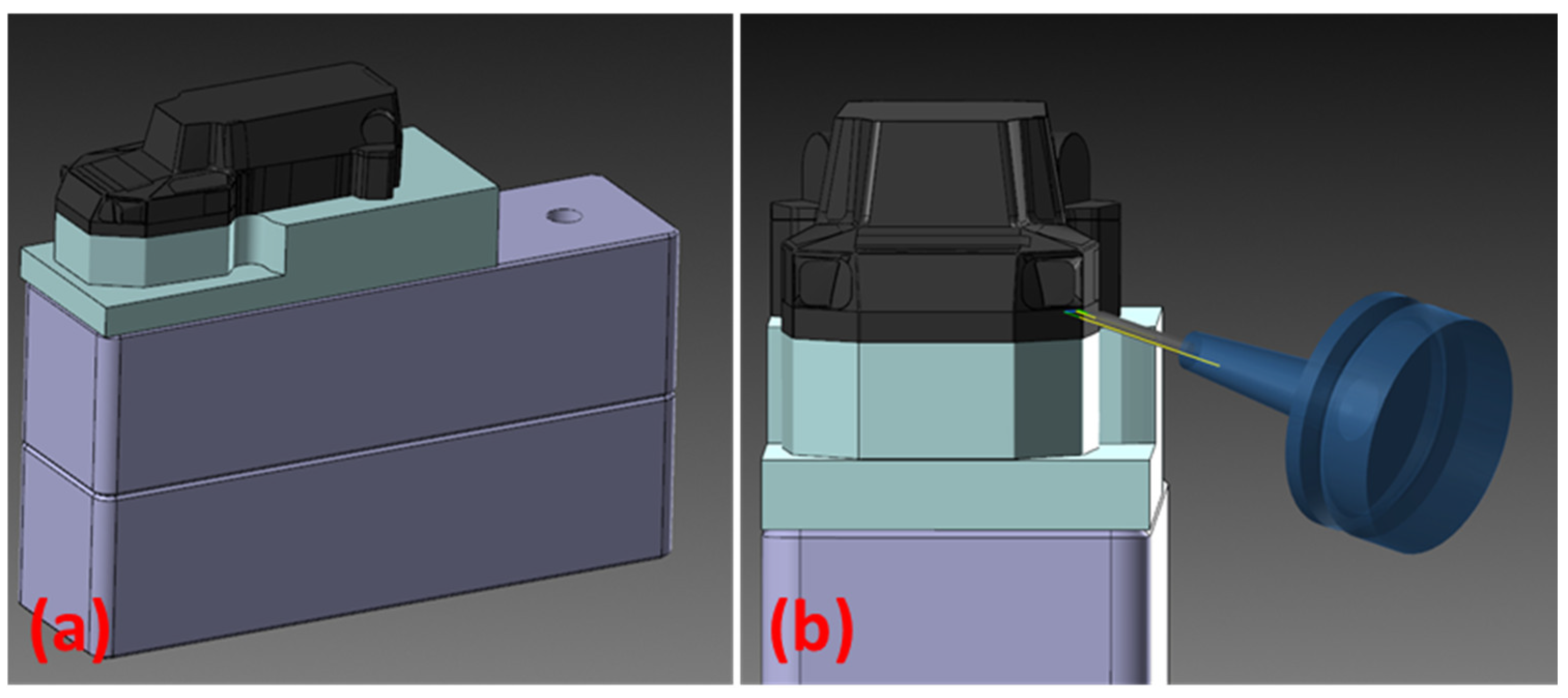


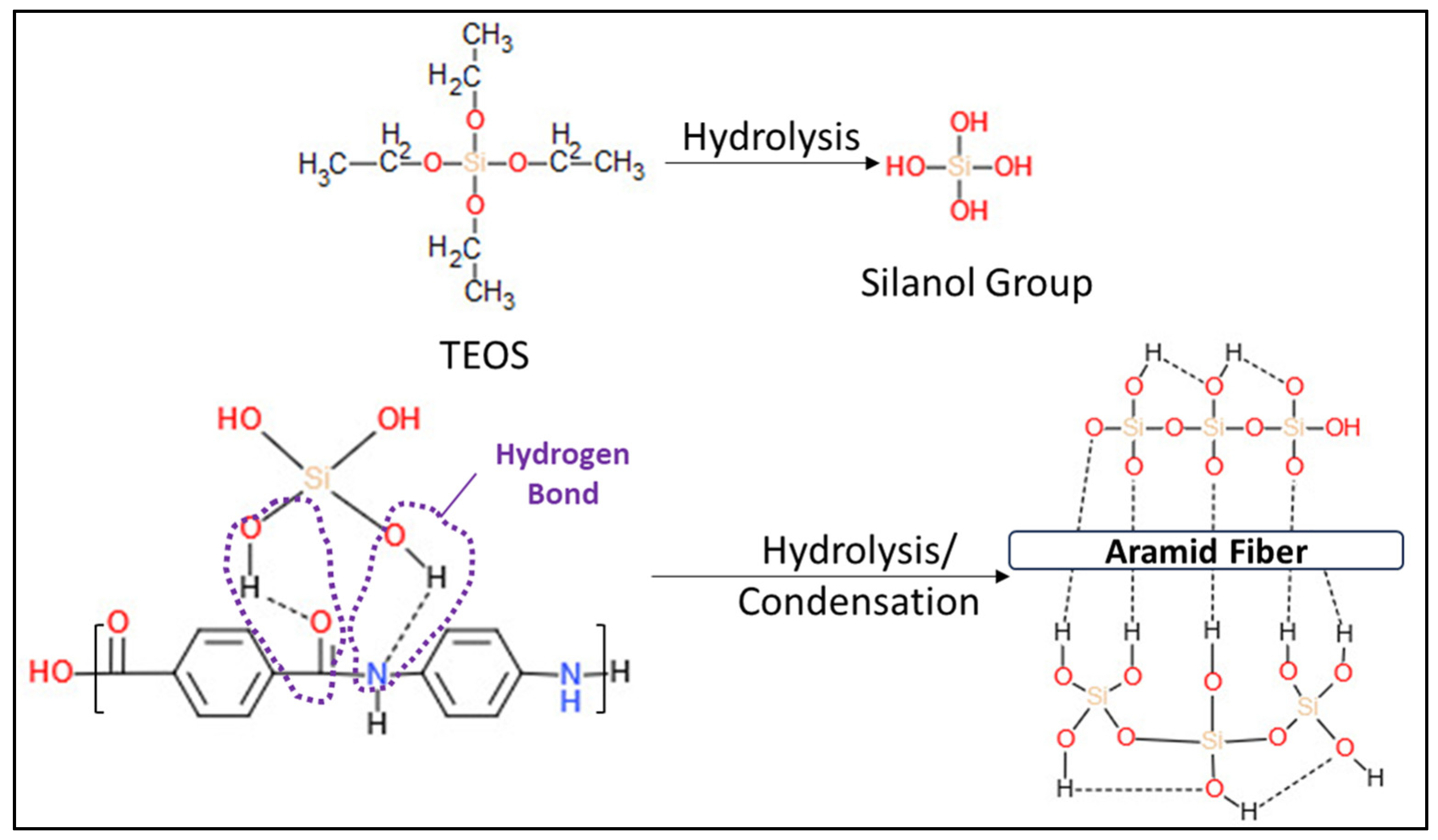

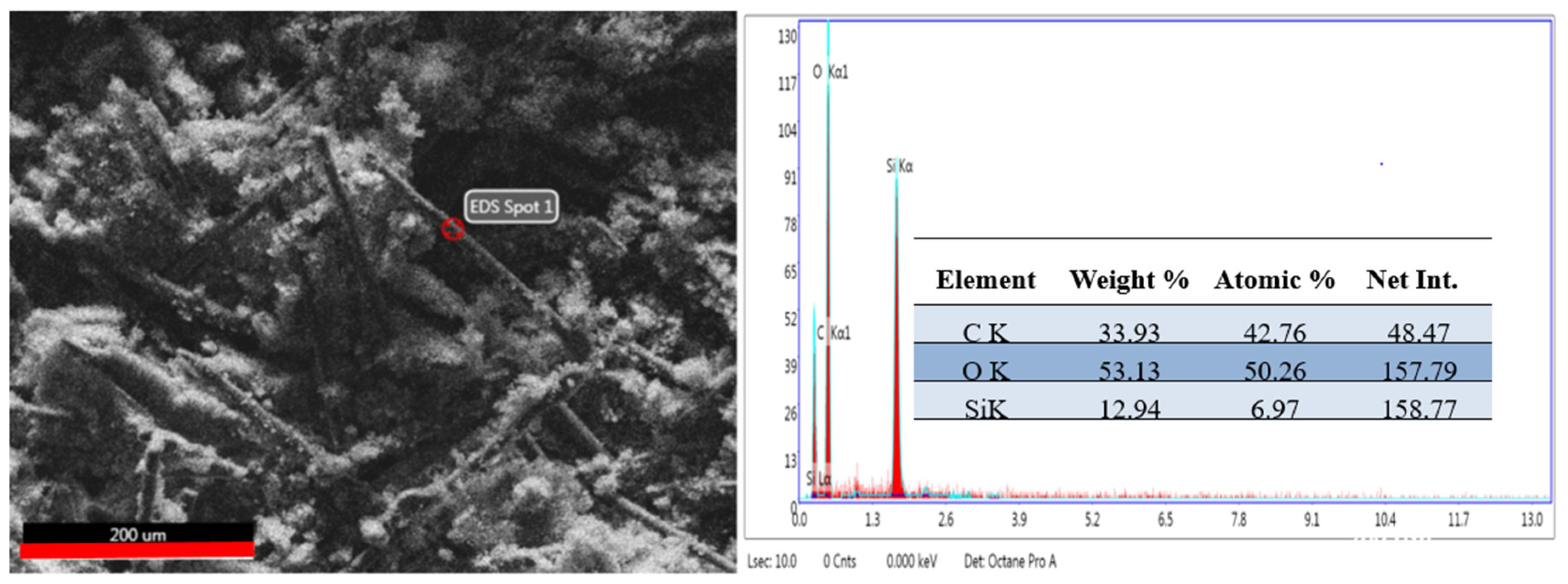
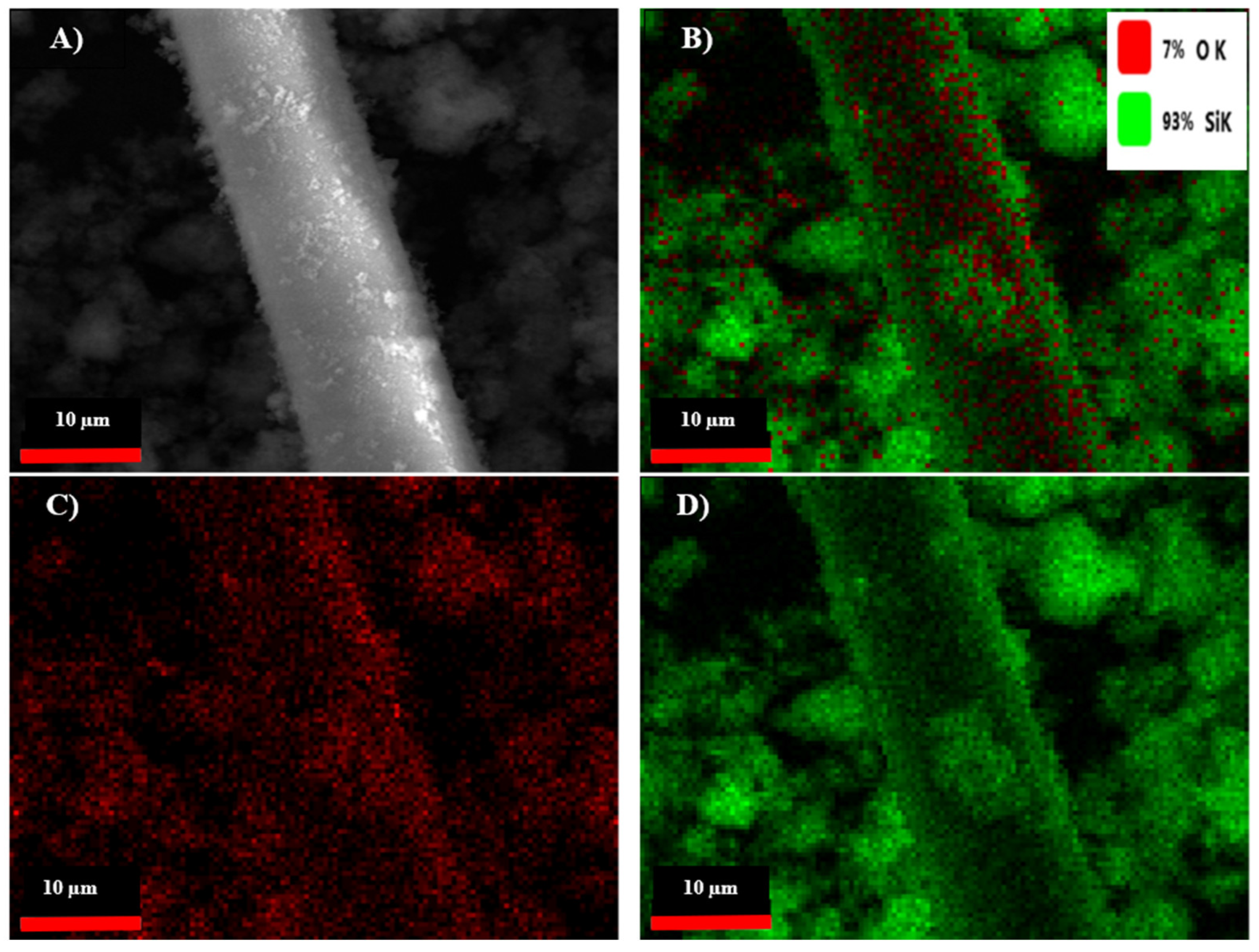


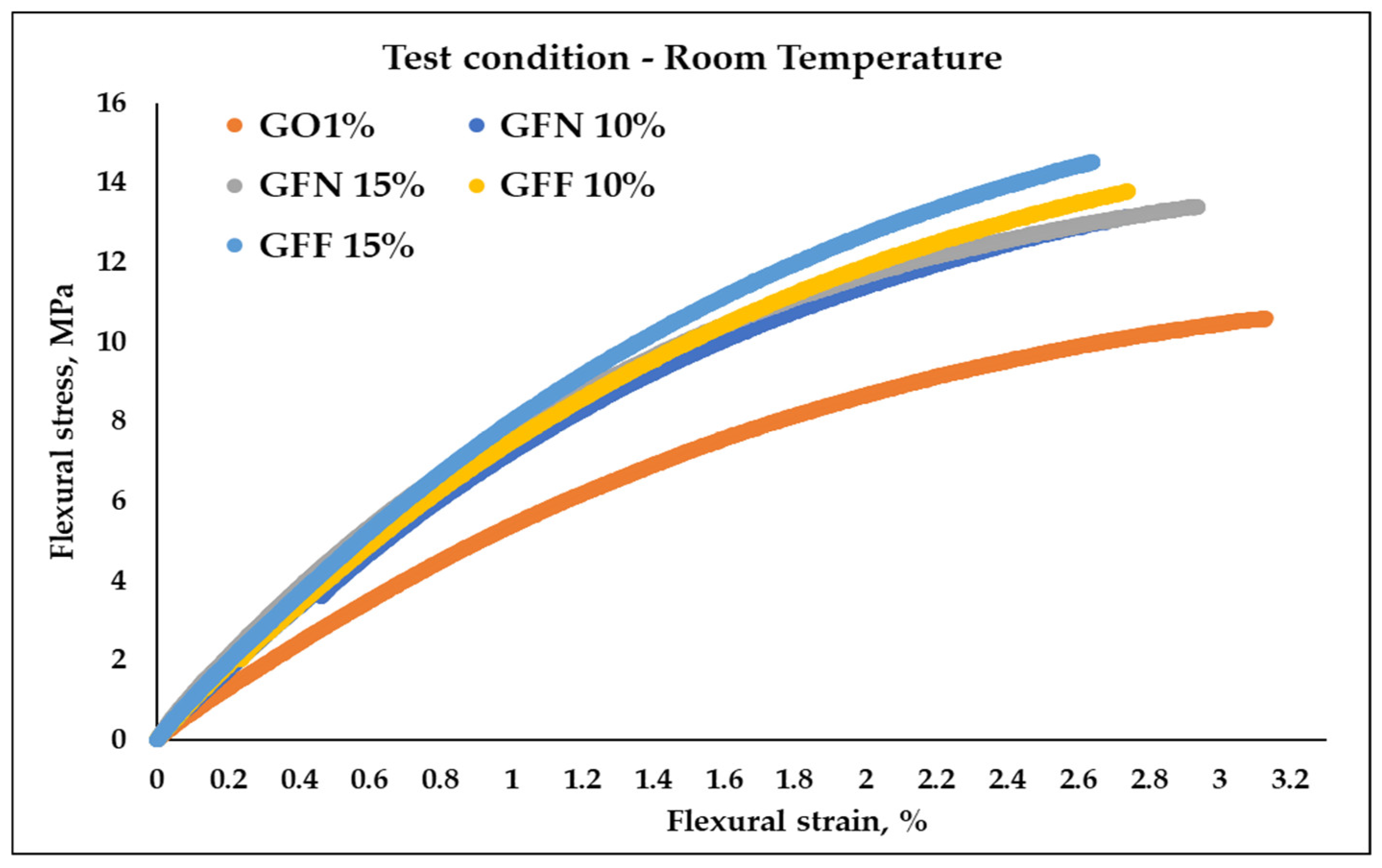

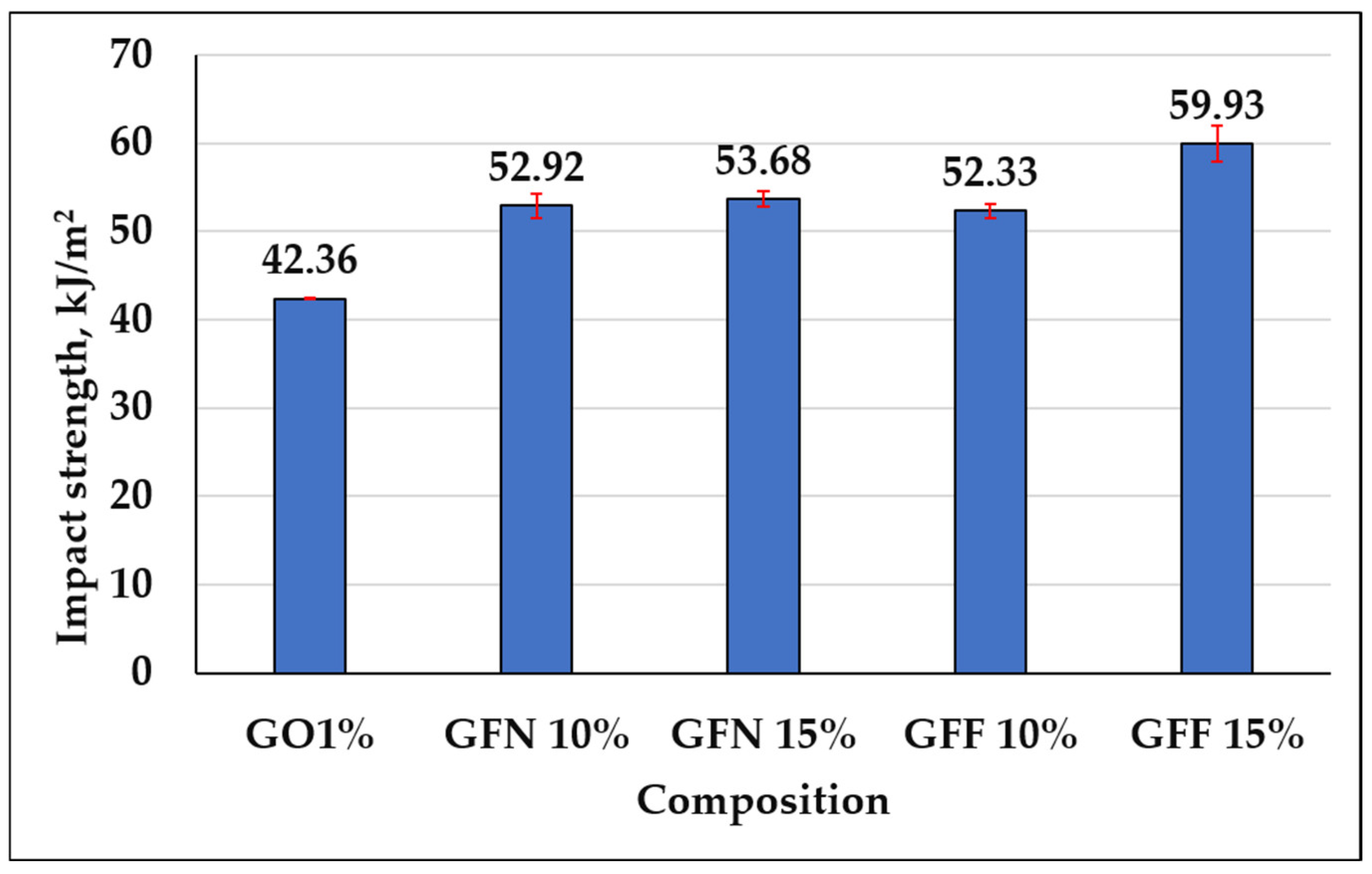

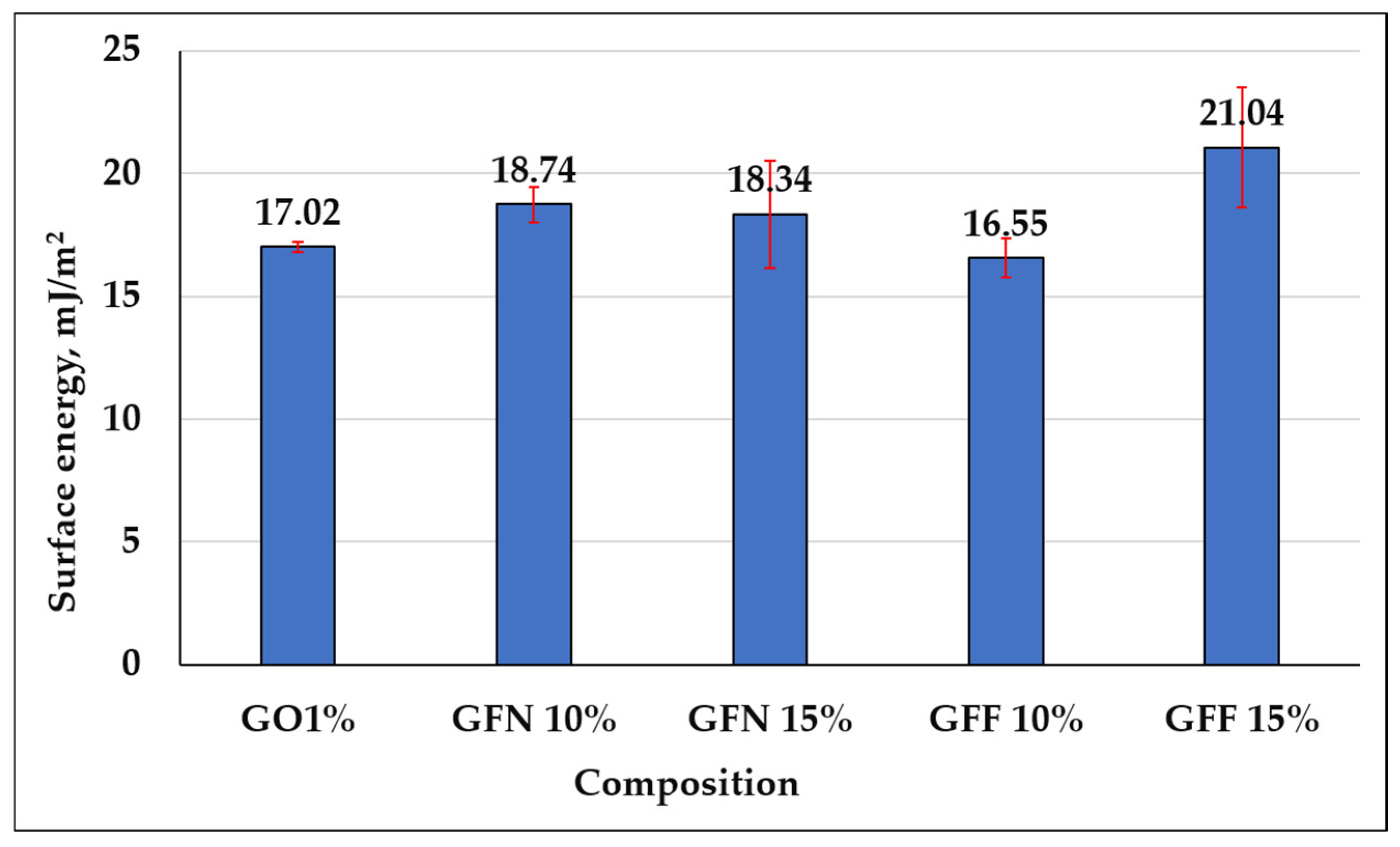
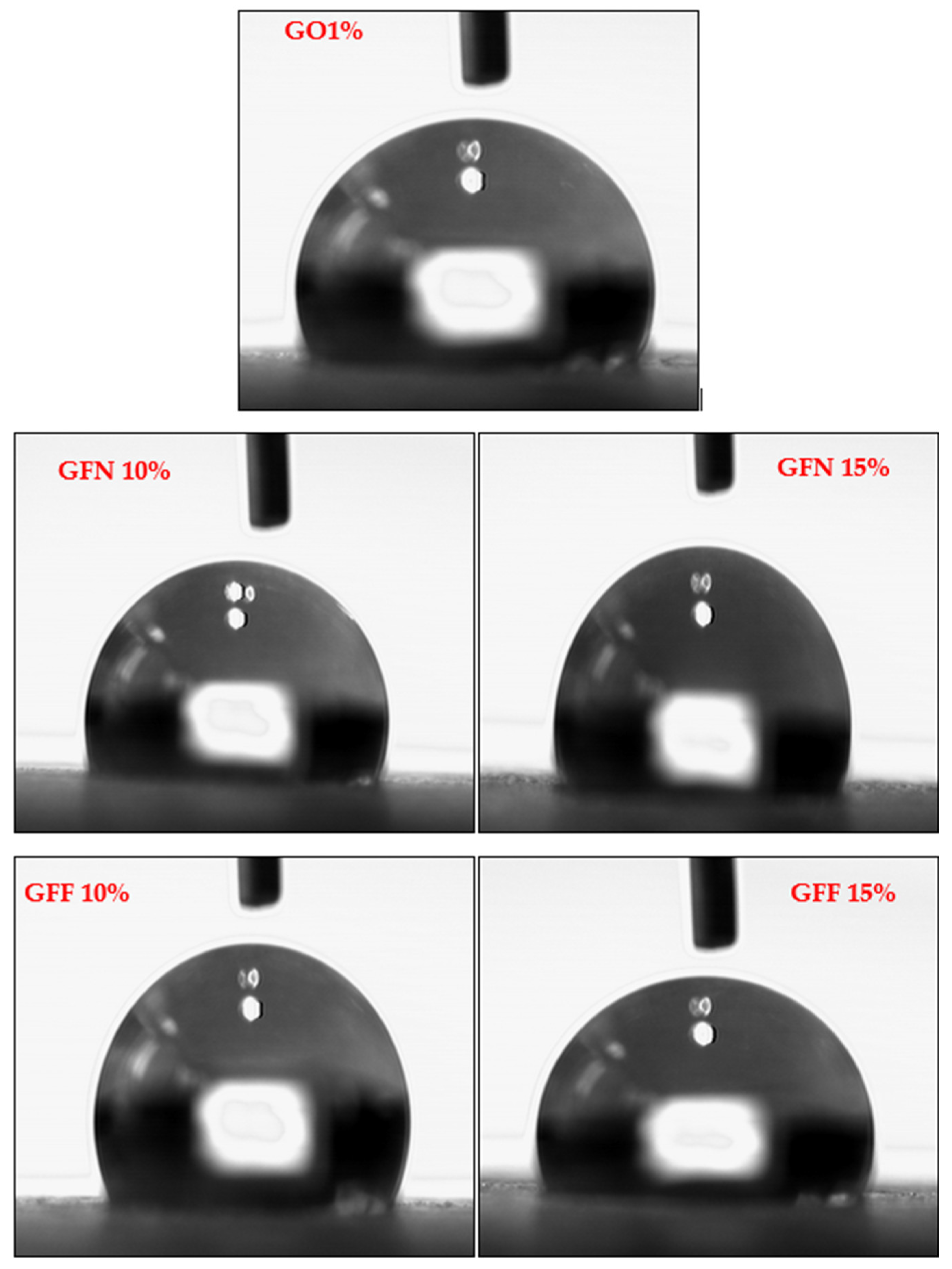
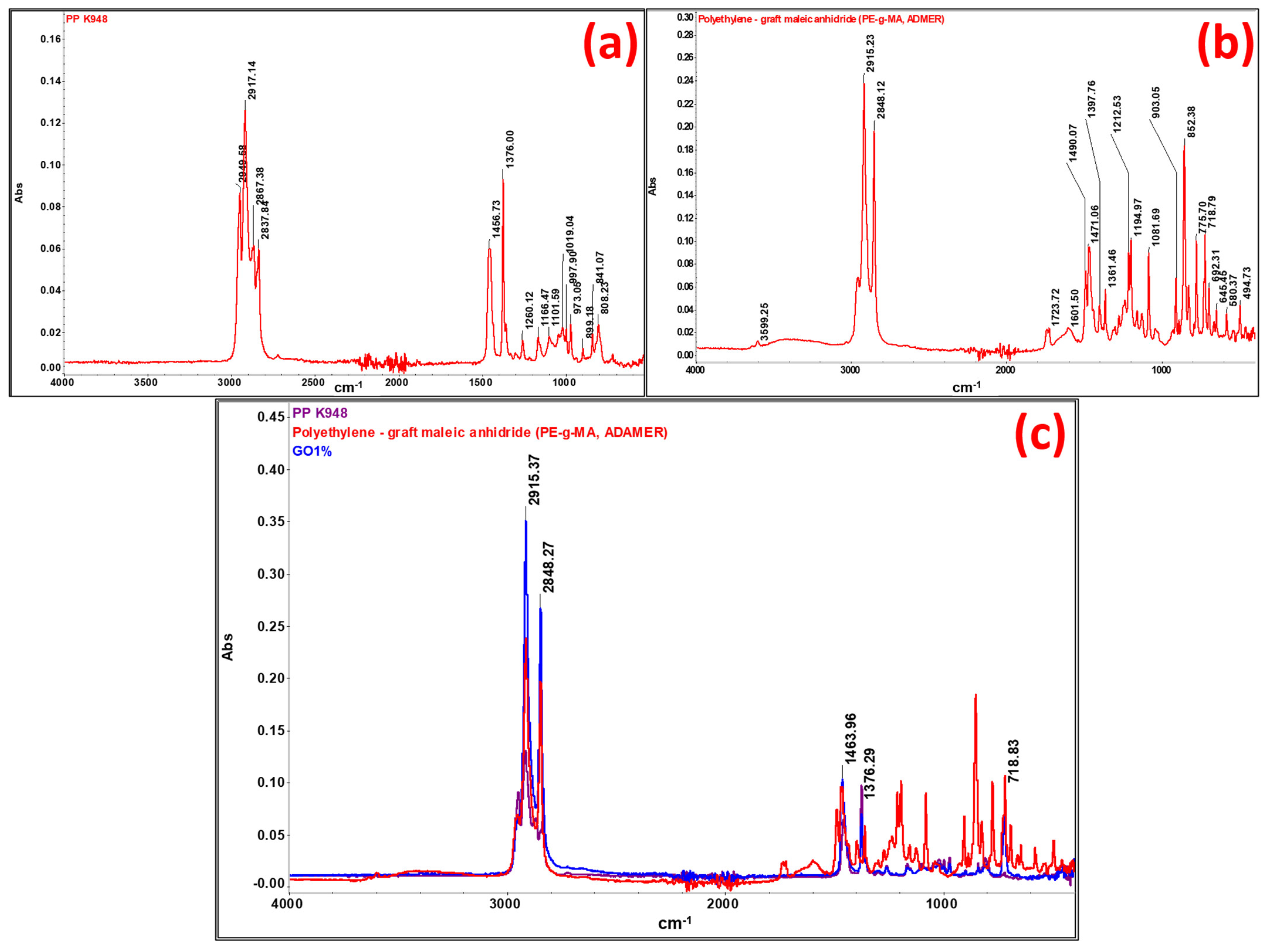


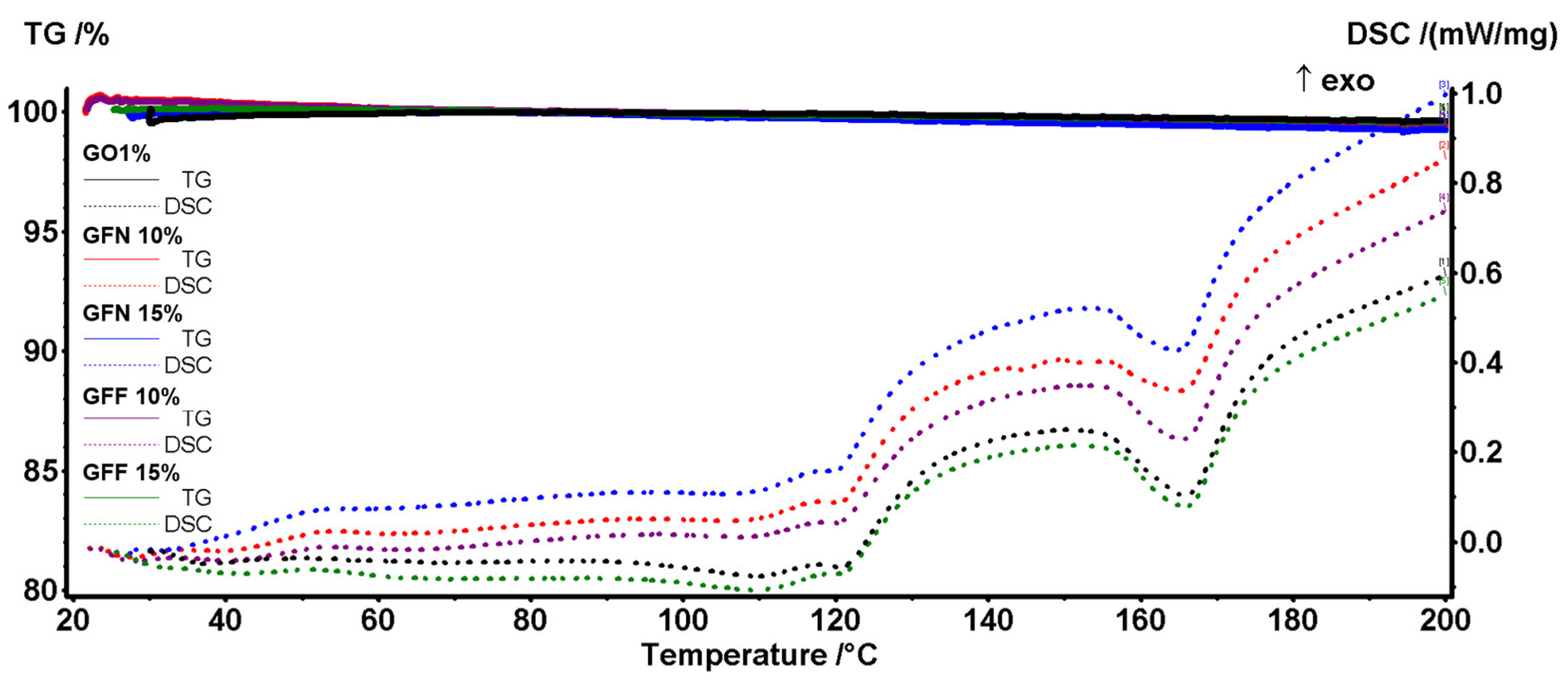
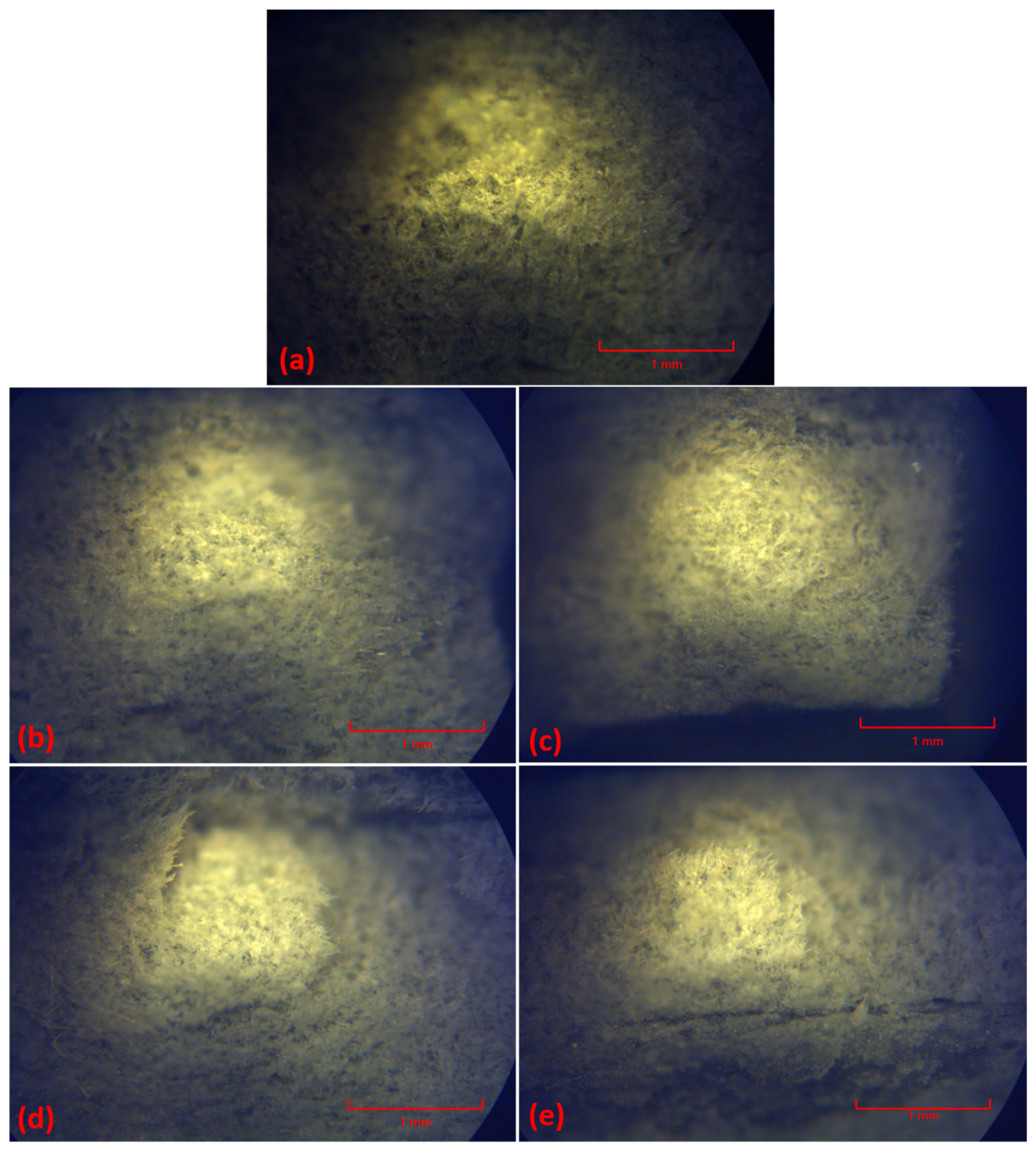

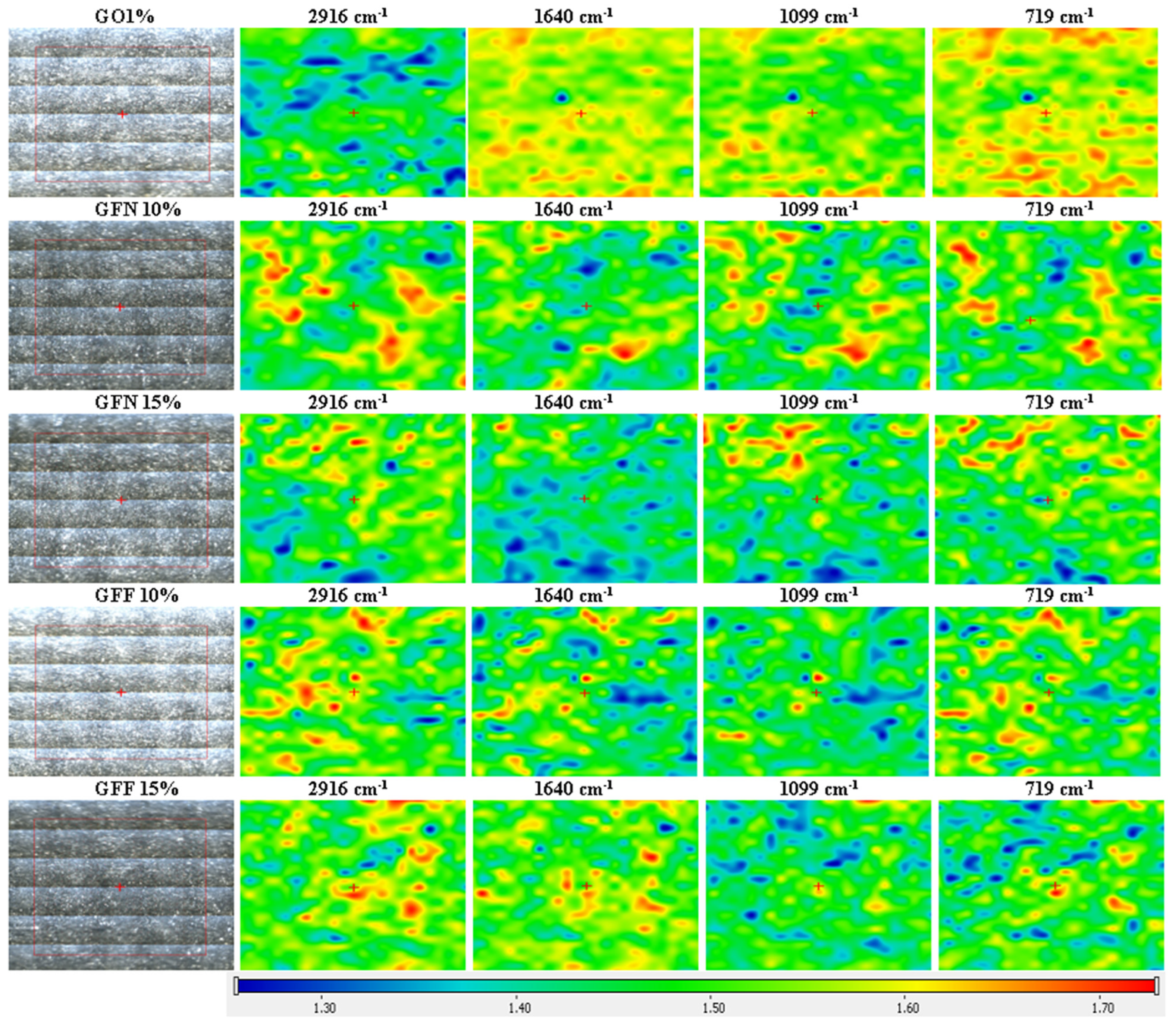


| Sample Code/Raw Materials | GO1% | GFN 10% | GFN 15% | GFF 10% | GFF 15% |
|---|---|---|---|---|---|
| PP K948 | 50 | 50 | 50 | 50 | 50 |
| PE-g-MA (Adamer) | 50 | 50 | 50 | 50 | 50 |
| Opaque gray pigment—Mastersafe MP-10-20B | 1 | 1 | 1 | 1 | 1 |
| Unmodified aramid fibers | - | 10 | 15 | ||
| Aramid fibers modified with SiO2 (TEOS precursor) | - | - | - | 10 | 15 |
| Polyethylene-based wax (relative to the fiber amount) | - | 5 | 5 | 5 | 5 |
| Composite Base Test (ASTM) | Onyx Characteristics |
|---|---|
| Tensile Modulus (GPa) D638 | 2.4 |
| Tensile Stress at Yield (MPa) D638 | 40 |
| Tensile Stress at Break (MPa) D638 | 37 |
| Tensile Strain at Break (%) D638 | 25 |
| Flexural Strength (MPa) D790 | 71 |
| Flexural Modulus (GPa) D790 | 3 |
| Heat Deflection Temp (°C) D648 B | 145 |
| Izod Impact Strength-Notched (J/m) D256-10 A | 330 |
| Density (g/cm3) | 1.2 |
| Parameter | Upper Mold | Lower Mold |
|---|---|---|
| Print time, h: min | 8:37 | 19:23 |
| Layer height, mm | 0.25 | 0.2 |
| Infill pattern | Hexagonal | Hexagonal |
| Infill density, % | 27 | 18 |
| Roof and floor no. of layers (height, mm) | 3 (0.75) | 7 (0.80) |
| Wall no. of layers (height, mm) | 2 (0.80) | 2 (0.80) |
| Total no. of layers | 163 | 274 |
| Mass, g | 141.86 | 161.47 |
| Plastic volume, cm3 | 131.56 | 147.75 |
| Sample Codification | Tensile Strength, MPa | Tensile Modulus, MPa | Tensile Strain, % |
|---|---|---|---|
| Test condition—Room temperature | |||
| GO1% | 7.3 ± 0.34 | 625.45 ± 109.26 | 18.36 ± 3.26 |
| GFN 10% | 8.46 ± 0.19 | 832.08 ± 49.78 | 12.74 ± 0.21 |
| GFN 15% | 8.61 ± 0.36 | 1037.31 ± 32.95 | 7.5 ± 0.13 |
| GFF 10% | 8.43 ± 0.16 | 788.28 ± 20.72 | 19.87 ± 1.58 |
| GFF 15% | 9.09 ± 0.12 | 917.33 ± 38.02 | 7.97 ± 0.39 |
| Test condition—+39 °C | |||
| GO1% | 7.14 ± 0.13 | 457.97 ± 65.54 | 52.54 ± 1.70 |
| GFN 10% | 7.66 ± 0.20 | 579 ± 19.98 | 24.64 ± 3.00 |
| GFN 15% | 8.55 ± 0.20 | 1020.11 ± 195.06 | 13.94 ± 0.20 |
| GFF 10% | 8.39 ± 0.42 | 641.73 ± 9.72 | 11.63 ± 2.34 |
| GFF 15% | 9.12 ± 0.05 | 753.9 ± 10.83 | 15.55 ± 0.18 |
| Sample Codification | Flexural Strength, MPa | Flexural Modulus, MPa | Flexural Strain, % |
|---|---|---|---|
| Test condition—Room temperature | |||
| GO1% | 10.62 ± 0.17 | 601.45 ± 14.48 | 3.12 ± 0.23 |
| GFN 10% | 13.8 ± 0.20 | 838.76 ± 91.58 | 2.74 ± 0.05 |
| GFN 15% | 13.43 ± 0.23 | 974.29 ± 34.78 | 2.93 ± 0.01 |
| GFF 10% | 13.81 ± 0.13 | 847.97 ± 33.46 | 2.74 ± 0.00 |
| GFF 15% | 14.54 ± 0.18 | 918.37 ± 5.91 | 2.64 ± 0.23 |
| Test condition—+39 °C | |||
| GO1% | 7.13 ± 0.14 | 460.86 ± 1.04 | 2.9 ± 0.11 |
| GFN 10% | 7.75 ± 0.08 | 572.17 ± 1.35 | 2.74 ± 0.13 |
| GFN 15% | 8.78 ± 0.03 | 621 ± 73.98 | 3.13 ± 0.08 |
| GFF 10% | 8.29 ± 0.01 | 587.99 ± 25.01 | 2.89 ± 0.13 |
| GFF 15% | 9.62 ± 0.17 | 614.74 ± 50.85 | 3.00 ± 0.09 |
| Sample | T5% (°C) | T10% (°C) | T50% (°C) | Mass Loss % RT-250 °C | Melting Peak (°C) | Decomposition Onset (°C) |
|---|---|---|---|---|---|---|
| GO1% | 326.9 | 353.9 | 400.3 | 0.38 | 154.8 | 165.9 |
| GFN 10% | 315.7 | 360.1 | 410.8 | 0.88 | 155.7 | 165.1 |
| GFN 15% | 304.4 | 341.9 | 406.5 | 1.09 | 154.7 | 164.7 |
| GFF 10% | 322.3 | 351.2 | 415.3 | 0.80 | 155.5 | 165.4 |
| GFF 15% | 325.0 | 354.4 | 414.7 | 0.77 | 155.7 | 165.7 |
Disclaimer/Publisher’s Note: The statements, opinions and data contained in all publications are solely those of the individual author(s) and contributor(s) and not of MDPI and/or the editor(s). MDPI and/or the editor(s) disclaim responsibility for any injury to people or property resulting from any ideas, methods, instructions or products referred to in the content. |
© 2024 by the authors. Licensee MDPI, Basel, Switzerland. This article is an open access article distributed under the terms and conditions of the Creative Commons Attribution (CC BY) license (https://creativecommons.org/licenses/by/4.0/).
Share and Cite
Sonmez, M.; Pelin, C.-E.; Pelin, G.; Rusu, B.; Stefan, A.; Stelescu, M.D.; Ignat, M.; Gurau, D.; Georgescu, M.; Nituica, M.; et al. Development, Testing, and Thermoforming of Thermoplastics Reinforced with Surface-Modified Aramid Fibers for Cover of Electronic Parts in Small Unmanned Aerial Vehicles Using 3D-Printed Molds. Polymers 2024, 16, 2136. https://doi.org/10.3390/polym16152136
Sonmez M, Pelin C-E, Pelin G, Rusu B, Stefan A, Stelescu MD, Ignat M, Gurau D, Georgescu M, Nituica M, et al. Development, Testing, and Thermoforming of Thermoplastics Reinforced with Surface-Modified Aramid Fibers for Cover of Electronic Parts in Small Unmanned Aerial Vehicles Using 3D-Printed Molds. Polymers. 2024; 16(15):2136. https://doi.org/10.3390/polym16152136
Chicago/Turabian StyleSonmez, Maria, Cristina-Elisabeta Pelin, George Pelin, Bogdan Rusu, Adriana Stefan, Maria Daniela Stelescu, Madalina Ignat, Dana Gurau, Mihai Georgescu, Mihaela Nituica, and et al. 2024. "Development, Testing, and Thermoforming of Thermoplastics Reinforced with Surface-Modified Aramid Fibers for Cover of Electronic Parts in Small Unmanned Aerial Vehicles Using 3D-Printed Molds" Polymers 16, no. 15: 2136. https://doi.org/10.3390/polym16152136
APA StyleSonmez, M., Pelin, C.-E., Pelin, G., Rusu, B., Stefan, A., Stelescu, M. D., Ignat, M., Gurau, D., Georgescu, M., Nituica, M., Oprea, O.-C., Motelica, L., Waśniewski, B., Ortyl, P., & Trușcă, R. D. (2024). Development, Testing, and Thermoforming of Thermoplastics Reinforced with Surface-Modified Aramid Fibers for Cover of Electronic Parts in Small Unmanned Aerial Vehicles Using 3D-Printed Molds. Polymers, 16(15), 2136. https://doi.org/10.3390/polym16152136









